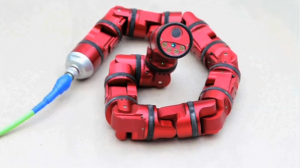 MAY 29 (Reuters) — Researchers have taken their serpentine machines, developed over decades at Carnegie Mellon University in the United States, and connected them to a central hub to create one of the most robust robots ever developed. Its creators have named it the Snake Monster.
MAY 29 (Reuters) — Researchers have taken their serpentine machines, developed over decades at Carnegie Mellon University in the United States, and connected them to a central hub to create one of the most robust robots ever developed. Its creators have named it the Snake Monster.
At the technology’s core, says robotics professor Howie Choset, are modules which connect to each other, allowing researchers to easily assemble and program task-specific robots in minutes.
“These modules that we have designed and other modules to be designed, they are like a smart Lego set. We are able to put the modules together as easy as Lego, but there is a lot going on underneath the hood to allow that to happen,” Choset said.
Each module has the computing power to control the entire robot. The pieces can be screwed together to form machines of various sizes and functionality. Once connected the modules communicate via Ethernet.
Choset says robots that can be easily assembled could potentially have a huge impact on how search and rescue operations are carried out in the future. He imagines a snake monster robot walking over rubble in a disaster zone, using its wheels to roll down a hill and then one of its legs to slither into a damaged building to search for survivors.
While the ultimate goal is to program these machines to work autonomously, Choset says humans will be able to control them using a robotic twin which will give an operator a ‘hands on’ interface to control the robot remotely.
“We built a force feedback master slave arm where the master controls one robot and the slave moves as the master requires,” Choset said, adding that the tasks these types of robots can perform are only limited to what developers can dream up to task them with. The Snake Monster can take a beating as well.
“That robot is field deploy-able. You can take that robot and throw it around, it’s robust. You can kick it and it is still going to work,” said Choset.
To test how quickly these modular robots can be assembled and programmed, one member of the team built and programmed one to feed him lunch. The entire process took less than 20 minutes, a delicious result for a robot with massive potential.







